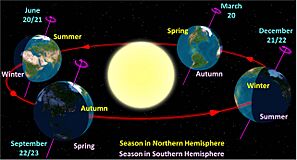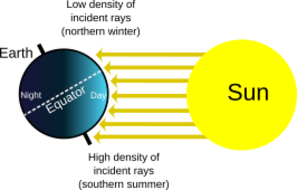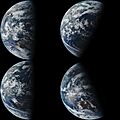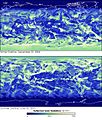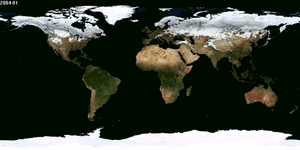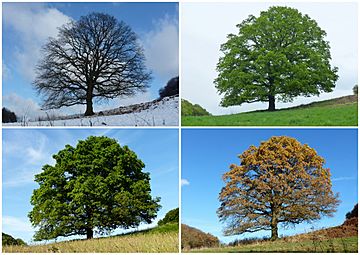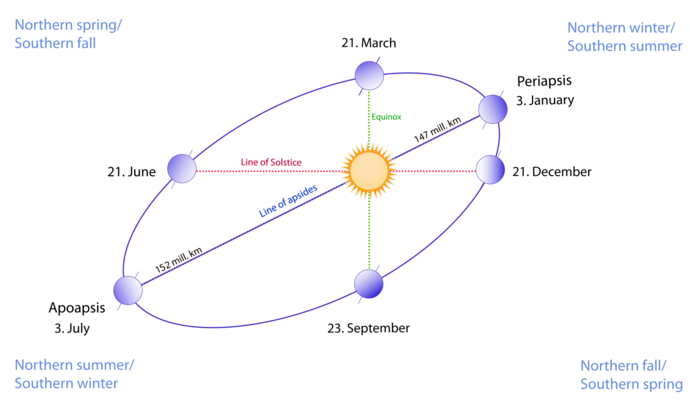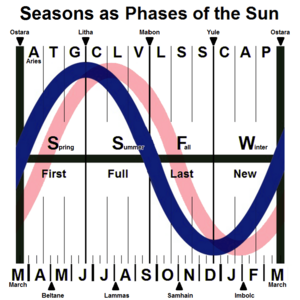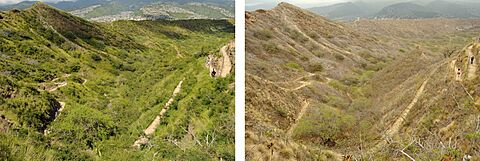Season facts for kids
Imagine the year as a big circle, and as Earth travels around the Sun, we experience different times called seasons. These seasons bring changes in weather, how nature looks, and how many hours of daylight we get each day. On Earth, seasons happen because our planet is tilted as it orbits the Sun. This tilt means that different parts of Earth get more direct sunlight at different times of the year.
In places far from the equator, like where many of us live, seasons change a lot. You'll see strong sunlight in summer and less intense light in winter. These changes make animals sleep through winter or travel to warmer places. Plants also go through cycles, like growing in spring and summer, then resting in winter. Different cultures around the world have their own ways of defining and celebrating seasons.
When the Northern Hemisphere (the top half of Earth) is tilted towards the Sun, it gets more direct sunlight. This happens around May, June, and July, bringing us summer. The Southern Hemisphere (the bottom half) experiences its summer when it tilts towards the Sun, usually in November, December, and January. Because of this tilt, the Sun appears higher in the sky during summer, making the days longer and warmer. However, the warmest months often come a little later than the longest days. This is because oceans and land take time to heat up, a process called seasonal lag. So, in the Northern Hemisphere, June, July, and August are usually the warmest months, while in the Southern Hemisphere, it's December, January, and February.
Many places with moderate climates, like Europe or North America, recognize four main seasons: spring, summer, autumn (also called fall), and winter. But in tropical areas near the equator, it's often different. They usually have two main seasons: a rainy or monsoon season and a dry season. Some tropical places even have a third "cool" season. Sometimes, "seasons" can also refer to important natural events, like hurricane season or wildfire season. Long ago, ancient Egyptians had seasons based on the Nile River's annual flood.
Seasons are very important for people who grow food. Their lives depend on when to plant and harvest. Many cultures have special celebrations and traditions to mark the changing seasons. For example, in India, people have recognized six seasons, or Ritu, for a very long time, based on their cultural calendars. These seasons help guide farming and trade.
Contents
Why Do We Have Seasons?
The main reason for Earth's seasons is how our planet moves around the Sun. It's all about Earth's tilt!
Earth's Tilt and Sunlight
Earth's axis of rotation is tilted by about 23.4 degrees compared to its path around the Sun. Think of it like a spinning top that's leaning over a bit. As Earth travels around the Sun, this tilt stays pointed in roughly the same direction, towards the North Star. This is called axial parallelism.
Because of this tilt, when the Northern Hemisphere is leaning towards the Sun, it gets more direct sunlight. This means longer days and warmer temperatures – that's summer! At the same time, the Southern Hemisphere is leaning away from the Sun, getting less direct sunlight, which brings shorter days and colder temperatures – that's winter for them. About half a year later, the situation reverses.
The angle of the Sun's rays also matters. When the Sun is low in the sky during winter, its light spreads out over a larger area, making it less intense. This, combined with shorter daylight hours, is why winter is colder.
Not About Distance from the Sun
Many people think that seasons happen because Earth is sometimes closer to the Sun and sometimes farther away. But this isn't true! Earth's orbit around the Sun is slightly oval-shaped (elliptical), so its distance from the Sun does change a little. However, Earth is actually closest to the Sun in January (called perihelion) and farthest in July (called aphelion).
This means that when the Northern Hemisphere has winter, Earth is actually closest to the Sun! The small change in distance only affects the amount of sunlight we get by about 7%. The tilt of Earth's axis is much more important for creating seasons.
Oceans and Weather Patterns
Local weather and seasonal changes are also affected by things like how close a place is to oceans, ocean currents, and strong winds. Large bodies of water heat up and cool down more slowly than land. This means coastal areas often have milder seasons than places far inland.
For example, the South Pole is much colder in winter than the North Pole. This is because the South Pole is in the middle of the continent of Antarctica, far from the ocean's warming effect. The North Pole, however, is in the Arctic Ocean, so the water helps keep its temperatures from getting quite as extreme.
Remember, when it's summer in the Northern Hemisphere, it's winter in the Southern Hemisphere, and vice versa!
Seasons Near the Equator
Close to the Equator, in the tropics, the amount of sunlight and temperature don't change much throughout the year. Earth's tilt doesn't affect these regions as strongly. Instead, the biggest seasonal changes are in how much rain they get.
Many tropical regions have a wet season (lots of rain) and a dry season (very little rain). When the rainy belt moves north of the Equator, the northern tropics get their wet season. When it moves south, the southern tropics get their wet season.
The Delay in Warmth and Cold
Even though the longest day of the year (summer solstice) is in June in the Northern Hemisphere, the hottest part of summer usually comes later, in July or August. This is called seasonal lag. It happens because the Earth's land and oceans take time to absorb and release heat. So, the peak warmth or cold is delayed by several weeks after the time of most or least sunlight.
How We Measure Seasons
People define seasons in different ways, depending on what they are observing.
Seasons by the Calendar (Meteorological)
Meteorologists, who study weather, define seasons by grouping months together. They consider summer the hottest three-month period and winter the coldest. This system was set up a long time ago by weather scientists.
In the Northern Hemisphere, meteorological seasons start on:
In the Southern Hemisphere, the seasons are opposite:
| Northern Hemisphere | Southern Hemisphere | Start Date | End Date |
|---|---|---|---|
| Spring | Autumn | 1 March | 31 May |
| Summer | Winter | 1 June | 31 August |
| Autumn | Spring | 1 September | 30 November |
| Winter | Summer | 1 December | 28 February (29th if leap year) |
Some countries, like Sweden and Finland, use "thermal seasons." These seasons start when the average daily temperature stays above or below certain points for several days. This means their seasons don't begin on fixed dates but are observed as they happen.
| Surface air temperature | |
|---|---|
| This diagram shows temperatures on the 21st of each month. It is based on data from Jones et al. |
This picture shows Figure 7 as published by Jones, et al. |
In India, the India Meteorological Department (IMD) recognizes four main seasons:
- Winter: December to February, the coldest months.
- Summer or pre-monsoon: March to May, the hottest months.
- Monsoon or rainy: June to September, dominated by heavy rains.
- Post-monsoon or autumn: October to November, usually clear skies in the northwest.
Seasons by the Stars (Astronomical)
Astronomical seasons are based on Earth's position in its orbit around the Sun. They begin at the solstices and equinoxes.
- The winter solstice (around December 21) marks the start of winter. This is the shortest day of the year.
- The spring equinox (around March 20) marks the start of spring. Day and night are roughly equal length.
- The summer solstice (around June 21) marks the start of summer. This is the longest day of the year.
- The autumn equinox (around September 22 or 23) marks the start of autumn. Day and night are roughly equal length again.
These astronomical seasons are not all the same length. This is because Earth's orbit is an ellipse, and it speeds up and slows down at different points. For example, the time from the March equinox to the September equinox is about 7.5 days longer than the time from the September equinox back to the March equinox.
Why Dates Shift
The exact dates of the equinoxes and solstices shift slightly each year. They usually fall about six hours later each year, which adds up to a full day every four years. Leap years help reset these dates to keep our calendar aligned with Earth's orbit. For example, in the 20th century, March 21, June 22, September 23, and December 22 were common dates for these events. Now, in the 21st century, the dates are more often March 20, June 21, September 22 or 23, and December 21.
Over thousands of years, Earth's tilt and orbit slowly change. This means that in the very distant future, the timing and strength of seasons will be different.
Old Ways of Marking Seasons (Solar)
Some older ways of defining seasons, especially in medieval Europe and by the Celts, considered the solstices and equinoxes as the middle of the seasons, not the start. This is called solar timing. For example, the summer solstice was seen as "midsummer."
On the Celtic calendar, the start of seasons was linked to four ancient festivals:
- Winter began around November 1 (Samhain, the origin of Halloween).
- Spring began around February 1 (Celtic Imbolc).
- Summer began around May 1 (Beltane, the origin of May Day).
- Autumn began around August 1 (Celtic Lughnasadh).
| Season | Start Date | End Date |
|---|---|---|
| Winter | 1 November (All Saints' Day) | 31 January |
| Spring | 1 February (St. Brigid's Day) | 30 April |
| Summer | 1 May (May Day) | 31 July |
| Autumn | 1 August (Lughnasadh) | 31 October (Hallowe'en) |
East Asian Solar Terms
In East Asia, traditional calendars, like the Chinese calendar, use 24 "solar terms" to divide the year. These terms help mark the seasons and guide farming. The four main seasons (spring, summer, autumn, winter) are centered around the solstices and equinoxes. For example, spring is said to begin around February 4.
Seasons Around the World
Beyond the main four seasons, many cultures and natural environments have their own unique ways of dividing the year.
Nature's Own Calendar (Ecological Seasons)
Ecologists, who study living things and their environment, define seasons by what happens in nature. For them, a season is when certain plants bloom or animals do specific things, like hibernate or migrate. These "ecological seasons" don't have fixed calendar dates; they depend on when nature actually changes.
For example, in many temperate places, you might see six ecological seasons:
- Prevernal (early spring): Buds swell on trees, some birds start migrating. (February-March)
- Vernal (spring): Tree buds open, birds build nests and lay eggs. (Mid-March-April)
- Estival (high summer): Trees are full of leaves, birds raise their young. (June)
- Serotinal (late summer): Leaves start changing color in some places, young birds mature. (Mid-August-September)
- Autumnal (autumn): Leaves turn bright colors and fall, birds migrate south. (Mid-September-October)
- Hibernal (winter): Trees are bare, migrating birds are in their winter homes. (November-December)
Indigenous Seasons
Many Indigenous people around the world have traditionally defined seasons by observing local plants, animals, and weather. These seasons are very specific to their environment. For example, some Indigenous Australian tribes recognize up to eight seasons in a year!
The Cree people in North America, for instance, use a six-season system that includes specific times for when ice freezes and breaks up on rivers and lakes.
| Cree Season | Approximate Months | English Translation |
|---|---|---|
| Pipon | Jan/Feb | Winter |
| Sekwun | Mar/Apr | Break-up (ice melts) |
| Mithoskumin | May/Jun | Spring |
| Nepin | Jul/Aug | Summer |
| Tukwakin | Sep/Oct | Autumn |
| Mikiskaw | Nov/Dec | Freeze-up (ice forms) |
The Noongar people of South-West Western Australia also have six seasons. Their seasons are marked by changes in winds, flowering plants, temperatures, and animal migration. Each season is also linked to different stages of human life and guided their movements across the land.
| Noongar Season | Approximate Months | Cultural Parallel |
|---|---|---|
| Birak (first summer) | December to January | Season of the young |
| Bunuru (second summer) | February to March | Season of adolescence |
| Djeran (autumn) | April to May | Season of adulthood |
| Makuru (the first rains) | June to July | Fertility season |
| Djilba (the second rains) | August to September | Season of conception |
| Kambarang (wildflower season) | October to November | Season of birth |
Tropical Wet and Dry Seasons
In tropical regions, instead of four seasons, it's more common to talk about the rainy (or wet) season and the dry season. For example, in Nicaragua, the dry season (November to April) is called "summer," and the rainy season (May to October) is called "winter," even though it's in the Northern Hemisphere. The amount of sunlight doesn't change much, but the amount of rain does.
Plants and animals in the tropics often time their life cycles around these wet and dry periods.
| Northern Hemisphere | Southern Hemisphere | Start Date | End Date |
|---|---|---|---|
| Dry season | Wet season | 1 November | 30 April |
| Wet season | Dry season | 1 May | 31 October |
Some tropical areas, like Thailand, even have three seasons: a cold season, a hot season, and a rainy season.
Polar Day and Night
If you go far north of the Arctic Circle or far south of the Antarctic Circle, you'll experience extreme seasons. In summer, there's a period called "polar day" or "midnight sun" where the Sun never sets! In winter, there's "polar night" where the Sun never rises. The higher the latitude, the longer these periods last.
For example, at a place called Alert in northern Canada, the Sun stays above the horizon for about five months straight during summer. Then, in winter, it disappears completely for about three months, with continuous darkness. Even before the Sun appears or after it sets, there are weeks of twilight, where the sky glows on the horizon.
Seasons and Human Activities
Weather and climate conditions can greatly affect human activities, including military operations. Historically, armies in Europe often planned their campaigns for the summer months. This was because farmers, who made up many soldiers, needed to be home for planting and harvesting. Also, dry summer ground or frozen winter ground made it easier to move troops and supplies. Spring thaws or autumn rains could turn roads into mud, making travel very difficult.
Navies also depend on seasons. Ice-free ports are crucial for ships to operate year-round. Countries like Russia have historically sought access to warm-water ports to keep their navies effective.
Related Pages
- Northern Hemisphere
- Southern Hemisphere
- Eastern Hemisphere
- Western Hemisphere
- Equator
- Tropic of Cancer
- Tropic of Capricorn
- Arctic Circle
- Antarctic Circle
See also
 In Spanish: Estaciones del año para niños
In Spanish: Estaciones del año para niños




